Verdict
The GameSir G8 Galileo is the most elite-level mobile game controller we’ve ever seen, with unparalleled physical controls and an impressive degree of flexibility.
Pros
- Superb build quality and controls
- Replaceable Hall Effect analogue sticks
- Works with a wide range of phones
Cons
- Iffy software, especially for iPhone users
- Not the most portable controller of its kind
- Not cheap
-
Compatibility with all USB-C phoneYou can connect the GameSire G8 Galileo to all Android phones and the new iPhone 15 range via USB-C. -
No charging requiredThe GameSire G8 Galileo doesn’t require any power, though it does have a USB-C port for passthrough phone charging. -
Free downloadable appThe GameSir app offers a window onto all of your installed games and streaming services, as well as a way to map controls.
Introduction
Chinese manufacturer GameSir is here to show that BackBone doesn’t have the premium mobile gaming market all to itself.
For a while there, mobile gamers were forced into a rather unsatisfactory choice. Hook up your favourite console controller and enjoy impeccable physical controls, but also diminished portability and flaky connectivity.
Alternatively, you could invest in a third-party USB controller and enjoy a higher degree of portability and dependability, but also suffer from inferior control quality and generally sub-standard build quality.
The BackBone One hinted that it was possible to have your cake and eat the majority of it. Now, the GameSir G8 Galileo is here promising a veritable all-you-can-eat cake buffet.
At a price of £79.99/$79.99, it manages to undercut the BackBone One by £20/$20, though it’s still hardly cheap. With a range of clever and compelling gamer-centric features on board, however, it might just represent good value.
Design
- Intuitive clamp system with clever movable USB-C connector
- Works with a wide variety of USB-C phones, including iPhone 15
- Replaceable Hall Effect analogue sticks
Like the BackBone One (and many other mobile controllers), the GameSir G8 Galileo features a simple expanding mechanism that envelops your phone, with the controls placed either side in a landscape orientation. Compared to the BackBone One, however, it’s relatively easy to operate without feeling like you’re going to Angry Birds your phone into your partner’s face.
I think there are a couple of reasons for that. One is that the mechanism itself feels more consistently sprung, with a wider and smoother-sliding bridge. Another is because GameSir has gone with a more open rubberised grip system, with none of the fiddly magnetised adapters of its rival.
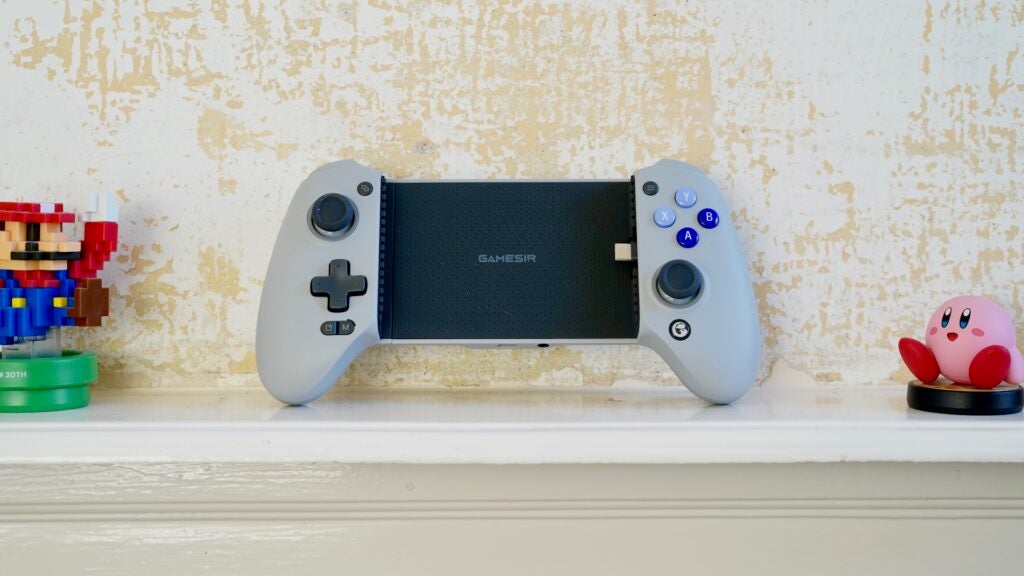
One of the reasons GameSir can get away with the latter is because it has implemented a clever hinged USB-C connector, which can flex up and down to fit a variety of phones. And yes, it does work with the iPhone 15 family out of the box, though there was an issue with app compatibility that I’ll come to later.
It remains to be seen how robust this USB-C port proves to be over the long haul, but during my test period in which I used the G8 with several phones, it worked like a dream. From the diddy iPhone 15 Pro to the hulking Redmagic 9 Pro, every phone I tried it with fitted great. Even the Pixel 8, which proved such a pain to pair with the BackBone One, worked beautifully here, with the chunky camera visor slotting neatly into the recessed expanding area.
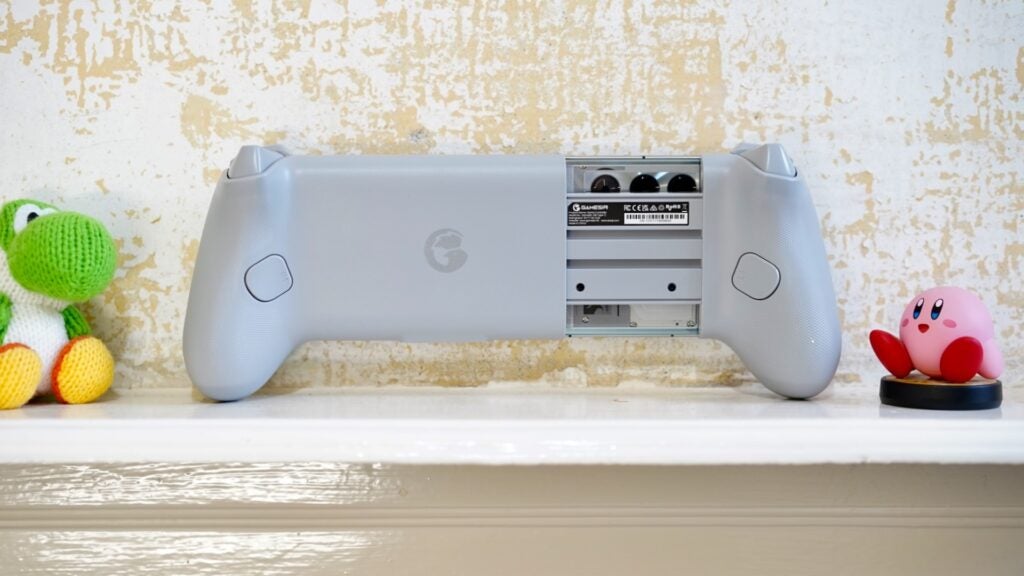
Another reason the GameSir G8 Galileo is so easy to handle is because of its sheer size. Compared to most of its rivals, it makes no concessions to portability, with everything geared towards a high-level gaming experience. It absolutely dwarfs the Backbone One, and at 253g is more than 100g heavier.
This is because the G8 Galileo adopts a traditional full-sized controller shape, as if an Xbox pad had been split in half. That counts for the control layout too, which has the full allotment of fascia buttons, four trigger buttons (including two Hall Effect analogue), twin analogue sticks, and a D-pad. There are two bonus mappable buttons on the back too.
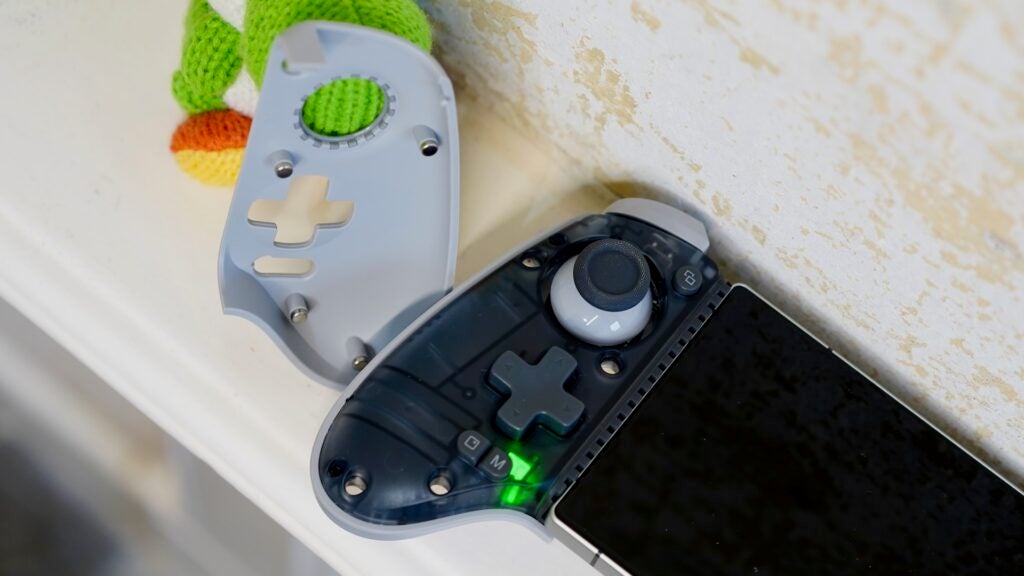
Those analogue sticks can be replaced by lifting off the G8 Galileo’s magnetised face plates, with three different stick options supplied in the box. Given that these are Hall Effect sticks, they’re already resistant to the kind of stick drift that affects regular console controllers.
You also get a 3.5mm headphone jack and a USB-C port on the bottom of device for pass-through phone charging.
Performance and gaming experience
- Outstanding Hall Effect analogue sticks
- Nice clicky D-pad
- Bonus controls around back
The GameSire G8 Galileo provides the best set of mobile gaming controls I’ve ever used. From the impeccably constructed, full-sized nature of the hand-holds to the quality of the controls, it feels and responds very much like a console controller.
Those high-quality (and full-sized) Hall Effect analogue sticks offer more precision in 3D action games than the BackBone One. Meanwhile, the D-pad is nice and precise for fast-paced 2D fare.
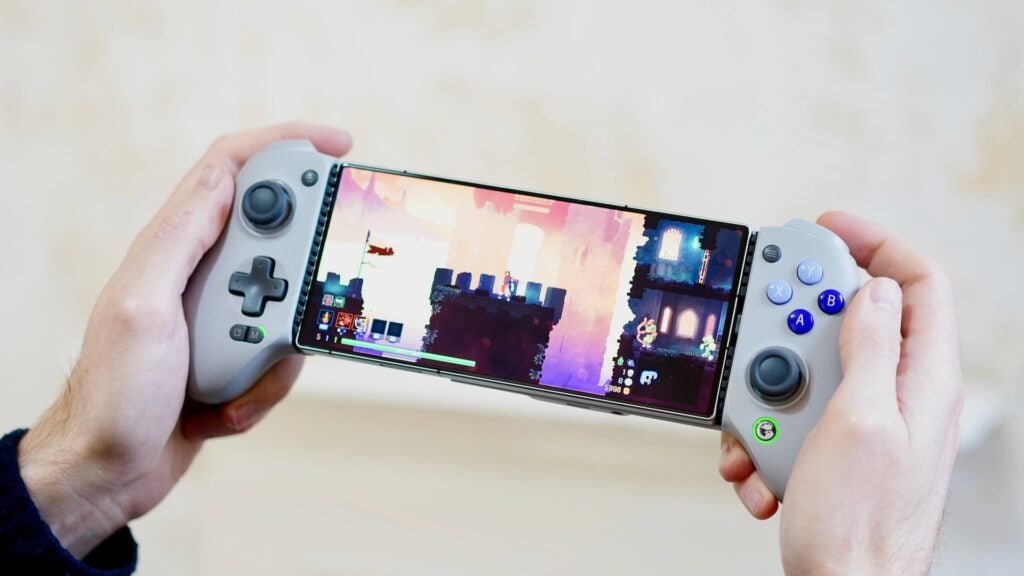
It passed the Dead Cells test with flying colours, with Motion Twin’s quick and fluid roguelite Metroidvania proving as responsive here as it does on console. Similarly, it worked great with Resident Evil 4 Remake on the iPhone 15 Pro, with the weighty sticks enabling me to pop those pressured headshots.
Wreckfest, meanwhile, feels every inch the glorious console racing game that it was meant to be when experienced through the G8 Galileo.
Though it isn’t immediately apparent, you can switch between three different gaming modes (iPhone and PS Remote Play, Android, and touchscreen games) by holding the two top menu buttons down. The latter mode lets you map physical controls even with games that don’t technically support USB-C controllers, such as COD Mobile and Genshin Impact.
Software
- Backbone app provides access to all your games
- TouchSync supports games with no controller support
- Streaming service support
If GameSir excels on the hardware front, it’s merely adequate when it comes to the software provision.
I found the downloadable GameSir app to be a little flaky in a number of ways, from failing to recognise the controller at all on iOS (though it still worked fine in controller-supported games) to receiving confusing pop-ups and momentary unresponsiveness when I plugged and unplugged a USB-C charger.
The app itself broadly resembles the chunky image-heavy layout of the Backbone app, only much less polished. Basic navigation seems a little clunky with the controller, with too much loaded onto the left analogue stick instead of the trigger buttons. It’s generally better to just use the touchscreen.
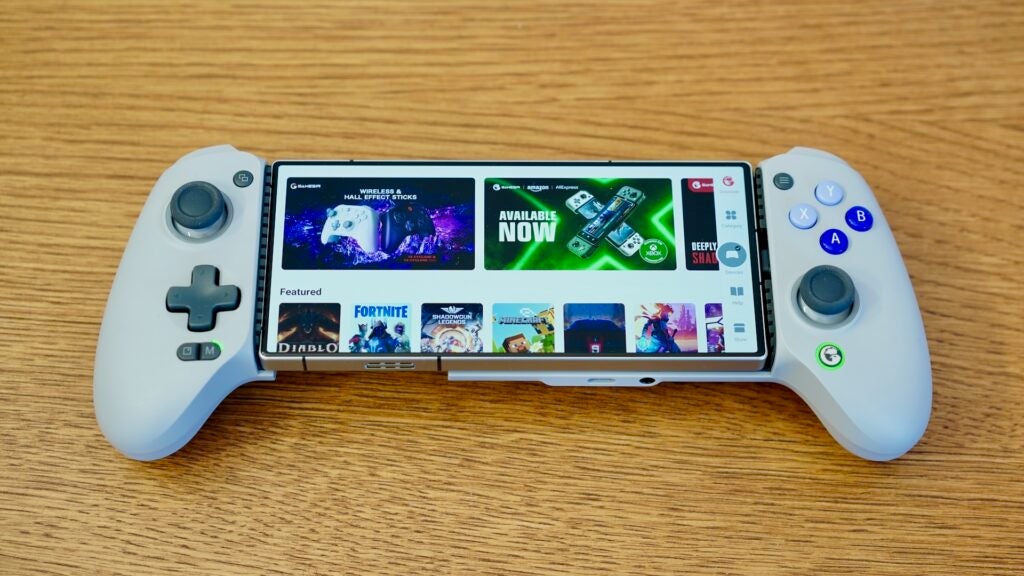
Tapping on one of the games from the recommended section (which features streaming services as well as the relevant app store) will initially flash it up in Mandarin text before quickly snapping to the English translation. Meanwhile, the menu screens outside the main UI are a little clunky, with help sections exhibiting weirdly squashed fonts and typos.
Talking of help sections, I initially appreciated the provision of the ability to hook the G8 Galileo up as a defacto wireless controller for a more direct CoD Mobile experience. However, the process proved to be finicky and poorly explained, and it ultimately didn’t work for me. I had to resort to the touchscreen button mapping method, which was thankfully more successful.
Latest deals
Should you buy it?
You want console-quality mobile gaming controls
With outstanding analogue sticks and buttons on full-sized controller sections, it’s the best there is.
You value portability
The GameSir G8 Galileo is one of the chunkier mobile game controllers on the market.
Final Thoughts
The GameSir G8 Galileo offers the finest set of mobile gaming controls on the market, bar none. It’s genuinely console-quality stuff, particularly with the full-sized handholds and replaceable Hall Effect analogue sticks.
It’s also compatible with a wide range of phones, fitting most Android devices and even the latest iPhones, and the attachment process is relatively simple.
As unimpeachable as the GameSir G8 Galileo’s hardware is, however, its software needs work, with an unappealing UI and a handful of flaky elements. There’s also no getting away from the fact that it isn’t particularly portable.
As such, the GameSir G8 Galileo can’t quite offer the all-round package that the BackBone One provides. In pure controller terms, however, it’s an elite performer.
How we test
We test all our devices thoroughly over an extended period of time. We use industry-standard tests to compare features properly. We’ll always tell you what we find. We never, ever, accept money to review a product.
Find out more about how we test in our ethics policy.
Was tested for at least two weeks before the review.
Played and streamed multiple games with the controller.
Used with an iPhone 15 Pro, a Redmagic 9 Pro, and a Google Pixel 8
FAQs
Yes, the open clamping system and flexible USB-C connector should ensure compatibility with all but the chunkiest of cases.
All USB-C Android phones, as well as the iPhone 15 family.
Yes, there’s a USB-C port on the bottom of the controller.
Verdict
The GameSir G8 Galileo is the most elite-level mobile game controller we’ve ever seen, with unparalleled physical controls and an impressive degree of flexibility.
Pros
- Superb build quality and controls
- Replaceable Hall Effect analogue sticks
- Works with a wide range of phones
Cons
- Iffy software, especially for iPhone users
- Not the most portable controller of its kind
- Not cheap
-
Compatibility with all USB-C phoneYou can connect the GameSire G8 Galileo to all Android phones and the new iPhone 15 range via USB-C. -
No charging requiredThe GameSire G8 Galileo doesn’t require any power, though it does have a USB-C port for passthrough phone charging. -
Free downloadable appThe GameSir app offers a window onto all of your installed games and streaming services, as well as a way to map controls.
Introduction
Chinese manufacturer GameSir is here to show that BackBone doesn’t have the premium mobile gaming market all to itself.
For a while there, mobile gamers were forced into a rather unsatisfactory choice. Hook up your favourite console controller and enjoy impeccable physical controls, but also diminished portability and flaky connectivity.
Alternatively, you could invest in a third-party USB controller and enjoy a higher degree of portability and dependability, but also suffer from inferior control quality and generally sub-standard build quality.
The BackBone One hinted that it was possible to have your cake and eat the majority of it. Now, the GameSir G8 Galileo is here promising a veritable all-you-can-eat cake buffet.
At a price of £79.99/$79.99, it manages to undercut the BackBone One by £20/$20, though it’s still hardly cheap. With a range of clever and compelling gamer-centric features on board, however, it might just represent good value.
Design
- Intuitive clamp system with clever movable USB-C connector
- Works with a wide variety of USB-C phones, including iPhone 15
- Replaceable Hall Effect analogue sticks
Like the BackBone One (and many other mobile controllers), the GameSir G8 Galileo features a simple expanding mechanism that envelops your phone, with the controls placed either side in a landscape orientation. Compared to the BackBone One, however, it’s relatively easy to operate without feeling like you’re going to Angry Birds your phone into your partner’s face.
I think there are a couple of reasons for that. One is that the mechanism itself feels more consistently sprung, with a wider and smoother-sliding bridge. Another is because GameSir has gone with a more open rubberised grip system, with none of the fiddly magnetised adapters of its rival.

One of the reasons GameSir can get away with the latter is because it has implemented a clever hinged USB-C connector, which can flex up and down to fit a variety of phones. And yes, it does work with the iPhone 15 family out of the box, though there was an issue with app compatibility that I’ll come to later.
It remains to be seen how robust this USB-C port proves to be over the long haul, but during my test period in which I used the G8 with several phones, it worked like a dream. From the diddy iPhone 15 Pro to the hulking Redmagic 9 Pro, every phone I tried it with fitted great. Even the Pixel 8, which proved such a pain to pair with the BackBone One, worked beautifully here, with the chunky camera visor slotting neatly into the recessed expanding area.

Another reason the GameSir G8 Galileo is so easy to handle is because of its sheer size. Compared to most of its rivals, it makes no concessions to portability, with everything geared towards a high-level gaming experience. It absolutely dwarfs the Backbone One, and at 253g is more than 100g heavier.
This is because the G8 Galileo adopts a traditional full-sized controller shape, as if an Xbox pad had been split in half. That counts for the control layout too, which has the full allotment of fascia buttons, four trigger buttons (including two Hall Effect analogue), twin analogue sticks, and a D-pad. There are two bonus mappable buttons on the back too.

Those analogue sticks can be replaced by lifting off the G8 Galileo’s magnetised face plates, with three different stick options supplied in the box. Given that these are Hall Effect sticks, they’re already resistant to the kind of stick drift that affects regular console controllers.
You also get a 3.5mm headphone jack and a USB-C port on the bottom of device for pass-through phone charging.
Performance and gaming experience
- Outstanding Hall Effect analogue sticks
- Nice clicky D-pad
- Bonus controls around back
The GameSire G8 Galileo provides the best set of mobile gaming controls I’ve ever used. From the impeccably constructed, full-sized nature of the hand-holds to the quality of the controls, it feels and responds very much like a console controller.
Those high-quality (and full-sized) Hall Effect analogue sticks offer more precision in 3D action games than the BackBone One. Meanwhile, the D-pad is nice and precise for fast-paced 2D fare.

It passed the Dead Cells test with flying colours, with Motion Twin’s quick and fluid roguelite Metroidvania proving as responsive here as it does on console. Similarly, it worked great with Resident Evil 4 Remake on the iPhone 15 Pro, with the weighty sticks enabling me to pop those pressured headshots.
Wreckfest, meanwhile, feels every inch the glorious console racing game that it was meant to be when experienced through the G8 Galileo.
Though it isn’t immediately apparent, you can switch between three different gaming modes (iPhone and PS Remote Play, Android, and touchscreen games) by holding the two top menu buttons down. The latter mode lets you map physical controls even with games that don’t technically support USB-C controllers, such as COD Mobile and Genshin Impact.
Software
- Backbone app provides access to all your games
- TouchSync supports games with no controller support
- Streaming service support
If GameSir excels on the hardware front, it’s merely adequate when it comes to the software provision.
I found the downloadable GameSir app to be a little flaky in a number of ways, from failing to recognise the controller at all on iOS (though it still worked fine in controller-supported games) to receiving confusing pop-ups and momentary unresponsiveness when I plugged and unplugged a USB-C charger.
The app itself broadly resembles the chunky image-heavy layout of the Backbone app, only much less polished. Basic navigation seems a little clunky with the controller, with too much loaded onto the left analogue stick instead of the trigger buttons. It’s generally better to just use the touchscreen.

Tapping on one of the games from the recommended section (which features streaming services as well as the relevant app store) will initially flash it up in Mandarin text before quickly snapping to the English translation. Meanwhile, the menu screens outside the main UI are a little clunky, with help sections exhibiting weirdly squashed fonts and typos.
Talking of help sections, I initially appreciated the provision of the ability to hook the G8 Galileo up as a defacto wireless controller for a more direct CoD Mobile experience. However, the process proved to be finicky and poorly explained, and it ultimately didn’t work for me. I had to resort to the touchscreen button mapping method, which was thankfully more successful.
Latest deals
Should you buy it?
You want console-quality mobile gaming controls
With outstanding analogue sticks and buttons on full-sized controller sections, it’s the best there is.
You value portability
The GameSir G8 Galileo is one of the chunkier mobile game controllers on the market.
Final Thoughts
The GameSir G8 Galileo offers the finest set of mobile gaming controls on the market, bar none. It’s genuinely console-quality stuff, particularly with the full-sized handholds and replaceable Hall Effect analogue sticks.
It’s also compatible with a wide range of phones, fitting most Android devices and even the latest iPhones, and the attachment process is relatively simple.
As unimpeachable as the GameSir G8 Galileo’s hardware is, however, its software needs work, with an unappealing UI and a handful of flaky elements. There’s also no getting away from the fact that it isn’t particularly portable.
As such, the GameSir G8 Galileo can’t quite offer the all-round package that the BackBone One provides. In pure controller terms, however, it’s an elite performer.
How we test
We test all our devices thoroughly over an extended period of time. We use industry-standard tests to compare features properly. We’ll always tell you what we find. We never, ever, accept money to review a product.
Find out more about how we test in our ethics policy.
Was tested for at least two weeks before the review.
Played and streamed multiple games with the controller.
Used with an iPhone 15 Pro, a Redmagic 9 Pro, and a Google Pixel 8
FAQs
Yes, the open clamping system and flexible USB-C connector should ensure compatibility with all but the chunkiest of cases.
All USB-C Android phones, as well as the iPhone 15 family.
Yes, there’s a USB-C port on the bottom of the controller.

























